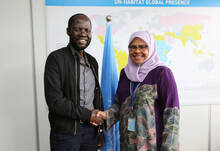In line with the Mid-Term Plans of Kenya’s Vision 2030, UN-Habitat continues to focus on providing support to human settlements and sustainable urbanization priorities of the Government of Kenya within the context of several frameworks including: President Kenyatta’s ‘Big Four Agenda for Transforming Kenya, which focuses on provision of affordable housing; the Implementing Strategy for The New Urban Agenda in Kenya (2016-2036); and the Habitat Country Programme Document for Kenya 2018-2021, a critical tool for mobilizing resources targeting implementation of programmes and projects at the national and county levels. UN-Habitat has been implementing 30 projects in 22 counties in Kenya, since 2013. Out of these, 11 are ongoing, while 19 have been completed.
Country: Overview
Country: Overview
Country: Overview
Impact
Country: Impact and Urban Numbers
139,851 people, among whom 27,200 are from vulnerable households, gained access to safe water due to UN-Habitat's interventions.
80,241 people have improved their access to sanitation facilities thanks to UN-Habitat's initiatives in Kenya.
139,851 people with access to safe water
Urban numbers
Country: Impact and Urban Numbers
Urban Growth Rate (2015-2020): 4.23%
Urban Population (2018): 27%
It is projected that more than half of the total population of Kenya will be living in urban areas by 2025.
Challenges
According to the 2009 official population census, Kenya had 38.6 million people and in 2011, the number was estimated to have risen to 41.07 million people (World Population Review). While only 27 percent of the total population lives in urban areas, the urbanization rate is high (4.3 percent per annum) and projections indicate that more than half of the total population will be living in urban areas by 2050. Already, the rapid population growth has over-stretched existing infrastructure and services, leading to the growth of informal settlements characterized by overcrowding, lack of basic infrastructures such as sewage, safe drinking water, and decent housing, poverty, and inequality, and consequently increased poverty and delinquency.
Our urban development projects
Country Beneficiaries

“This market upgrade project will transform how traders sell their wares at Nyakwere market. Previously, women traders sold cereals and vegetables on muddy, dirty ground posing public health risks. Soon, the upgrade will result into a shade with concrete slab, water and sanitation facilities promoting a safe and more secure environment that allows trading for longer hours and that increases revenue for local economic development, rural – urban linkages and better human settlements.”
Dr. David Okeyo, County Executive Committee Member for Trade, Homabay County
Donors and partners
The success of our work in Kenya is dependent on successful partnerships. Within the United Nations Kenya Country Team (UNCT), UN-Habitat is collaborating with FAO, UNDP, UNOPS & UNCDF in the implementation of the United Nations Joint Programme on Spatial Planning (UNJPSP). Further, UN-Habitat and UNHCR are collaborating in the preparation of the Kalobeyei Advisory Integrated Settlement Plan in Turkana County within the framework of the Kalobeyei Integrated Socio-Economic Development Program (KISEDP) that also includes the national & county governments. Overall, the Kenya Habitat Country Programme Document (HCPD 2018-2021) has been developed and is being implemented through a collaboration involving the national and county governments, Civil Society Urban Development Platform, Kenya Private Sector Alliance, Universities that teach Urban & Regional Planning and Architecture as well as Kenya Alliance of Residents Association.
Donors
Donors
Contact
Legacy content
Images







